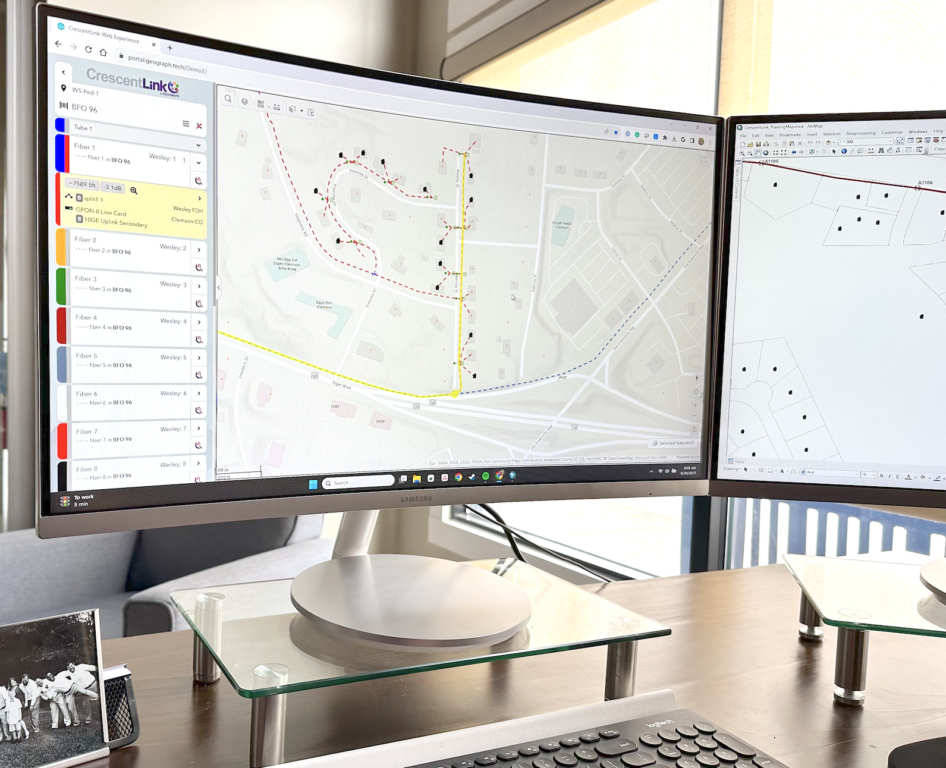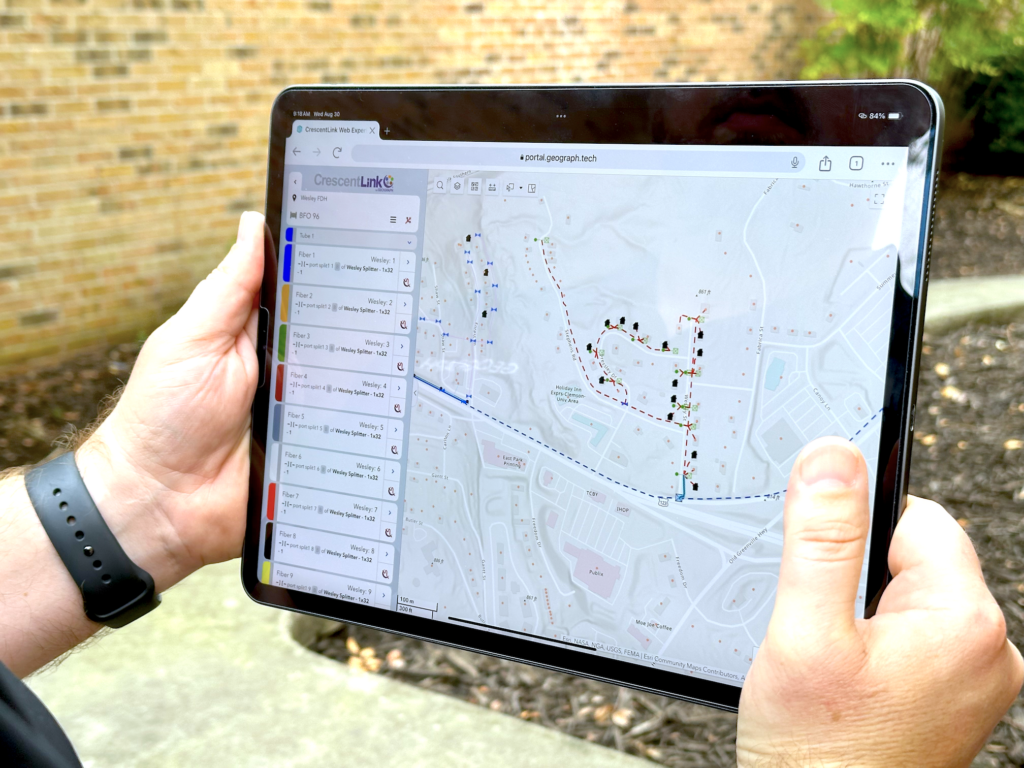GIS fiber mapping is a highly-effective means of collecting, visualizing, and analyzing fiber data to manage a network. GIS location information can be used to quickly identify best methods to plan, build, and manage a fiber network, all while providing a host of operational efficiencies and improve your return on investment.
But there are some areas related to fiber mapping that might cause concern to those just starting out. These areas can include upfront infrastructure costs, onboarding processes, and software licensing fees. However, if you understand the concerns before embarking on a fiber mapping project, you are sure to manage them with ease.
Let’s explore a few pros and cons related to fiber optic GIS mapping so you can make an informed decision about how to proceed and ensure a successful outcome.
5 Benefits of Fiber Mapping
There are many pros of utilizing a geographic information system, or GIS, for fiber mapping. Most businesses, in fact, find that there are more benefits than hurdles. Here are a few benefits that you can expect.
1. Faster and More Precise Network Management
Fiber maps, or digital twins, that utilize GIS technology, provide end-to-end visibility so you, and others in your organization, can easily view, manage, and analyze data. No more CAD diagrams, spreadsheet files, or random notes on paper. Instead, your digital maps will show a visual representation of your network so you can easily see the big picture view of how your network is laid out. The fiber map, or digital twin, will allow you to spatially see where your fiber is running, where splice points are located, how the fibers are connected, and what availability is left within each tube.

2. Streamlined Workflows
Fiber mapping with GIS technology is a huge efficiency tool for businesses upgrading from other systems. With all your fiber data in one place, in a single source, staff from any number of departments can access data to make quick decisions and eliminate redundancies. By creating streamlined workflows through automation, and reducing the need for your staff to investigate issues via time-consuming processes, fiber mapping can save both time and money. For example, your Customer Services reps have the same customer connectivity information as your Marketing Team, and your GIS Team. Everyone can view and analyze the same accurate data set to make decisions and improve customer service and performance levels.
3. Global View to Data Set
GIS fiber management solutions provide highly-accurate location information and can help locate outages and troubleshoot issues faster than manual record-keeping methods. With a distance trace and OTDR data, it is possible to narrow down an area of concern, while you are in your office, at the first sign of trouble. One person can view your digital fiber map data — your system of record, and within minutes, can find an outage area or location, and then make proper plans to remedy the trouble.

There are other benefits to having a digital view of your map data. Some of these include enhanced capabilities when reporting broadband data service levels per the FCC Broadband Data Collection regulations and having the ability to improve network performance by tracking maintenance activities such as equipment repair work and upgrades.
4. Easier Network Planning
Route selection and network planning and design is also easier with GIS fiber mapping. With a centralized repository you can more easily view and analyze network data to properly plan for new installations. This includes the ability to identify the most efficient routes, predict network capacity requirements, and the ability to quickly optimize network performance.
With a digital map you create a foundation for future growth. You will know where things are before you plan, so you can accurately predict your future return on investment for new projects.
5. Easy Access to Data
Fiber mapping makes sharing key information with all relevant stakeholders more accurate and convenient. Your Asset Accuracy, Outage Management, Circuit Management, Planning & Design, Construction Prints, and Inventory teams can all realize efficiencies by drawing fiber connection data from one single source map.
It’s worth noting that there are plenty of additional potential benefits that the short list presented here. Your results are dependent on your system and your ability to incorporate all map assets together. But these five benefits provide a great start toward understanding your pathway to a brighter future with a fiber management software solution and fiber mapping.
3 Drawbacks of Fiber Mapping
When weighing the pros and cons of fiber optic mapping, you’ll find that there really aren’t many negative aspects, and likely none that would be with you, and your organization, for the long term. Most “cons”, as those mentioned below, are related to the initial onboarding phase, as you switch from an existing system to a digital system. That having been said, you should be aware of these potential areas, so you can properly plan for them and you avoid unexpected surprises.
These areas for concern include:
1. Upfront Infrastructure Costs
Switching to GIS for fiber mapping may require significant upfront costs to set up your infrastructure. These costs might include labor to connect your fiber mapping system with other IT infrastructure in place at your organization. This could also include labor to help connect or input data points associated with each customer or business in your network.
2. Team Onboarding Processes
You’ll need team members who can use your GIS and mapping systems. If your team does not have experience in GIS or fiber mapping then a training plan is a good way forward.
3. Software Licensing Fees
Licensing fees for GIS software and data sources can sometimes be costly, but all this depends on the number of users in your organization, the number of customers you serve, and the size of your network. For smaller companies, with only one or a few users, the costs are less significant. For larger companies, with more staff having access to the GIS and fiber mapping software, an Enterprise license might be a better value.
See How GEOGRAPH Can Improve Your Fiber Mapping Experience
Using GIS and fiber mapping to manage your network is an investment that will pay dividends for years to come. Once your map is created it can provide you with the data you need to more accurately plan, build, and manage your network in ways you might now only imagine. We believe you will experience:
- Saved employee time
- Increased customer satisfaction
- Improved service level performance
- Preservation of company and network knowledge
- A foundation for future growth.
In addition, you’ll enjoy peace of mind knowing that you have full knowledge of your network. You will have created a resource that is complete, accurate, and that can be refreshed as your network changes. You will have a true, enterprise-wide, data intelligence platform to support a better, well-informed future, one that includes improved operational efficiency and return on investment .
Now that you are more informed about the pros and cons of fiber optic mapping using GIS technology, we invite you to do your own research. If at any point in time you have questions about how switching to GIS fiber mapping software could help you and your business, just contact us!






